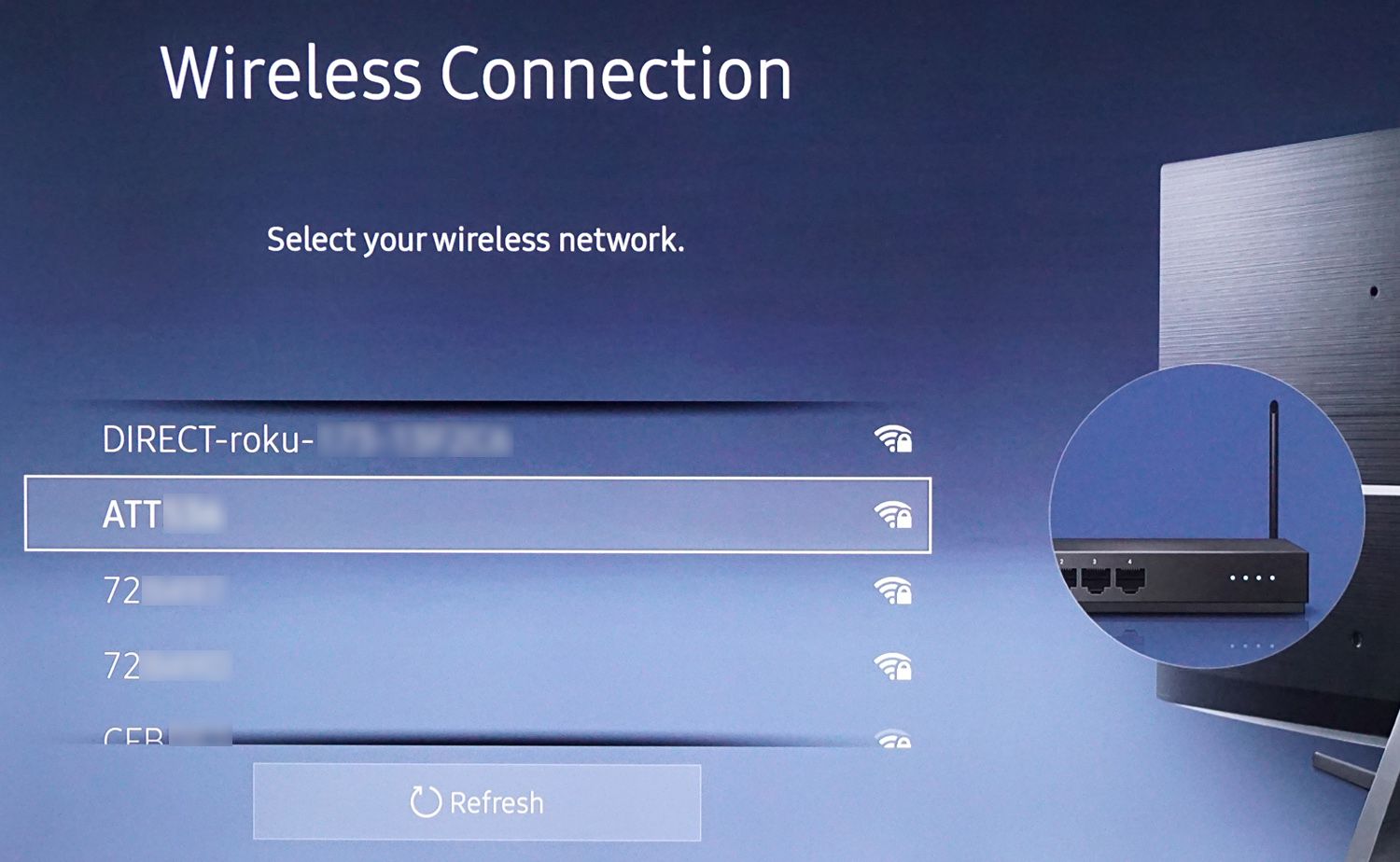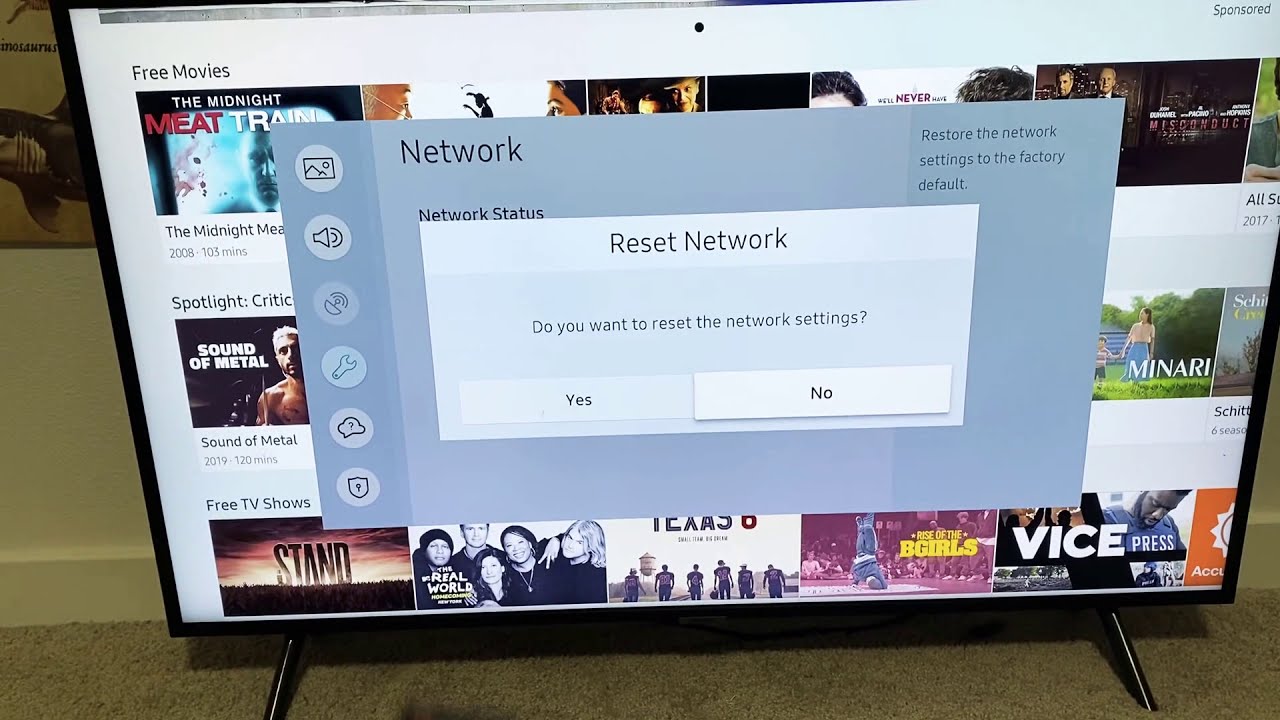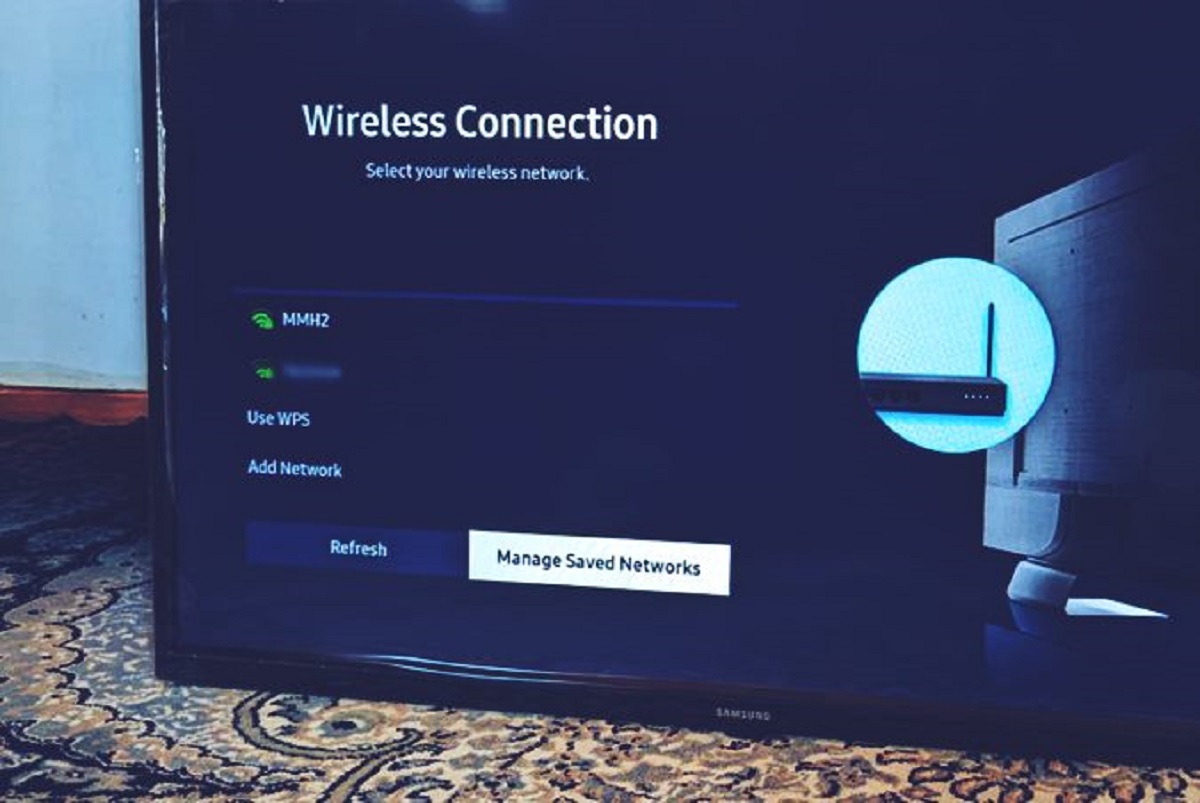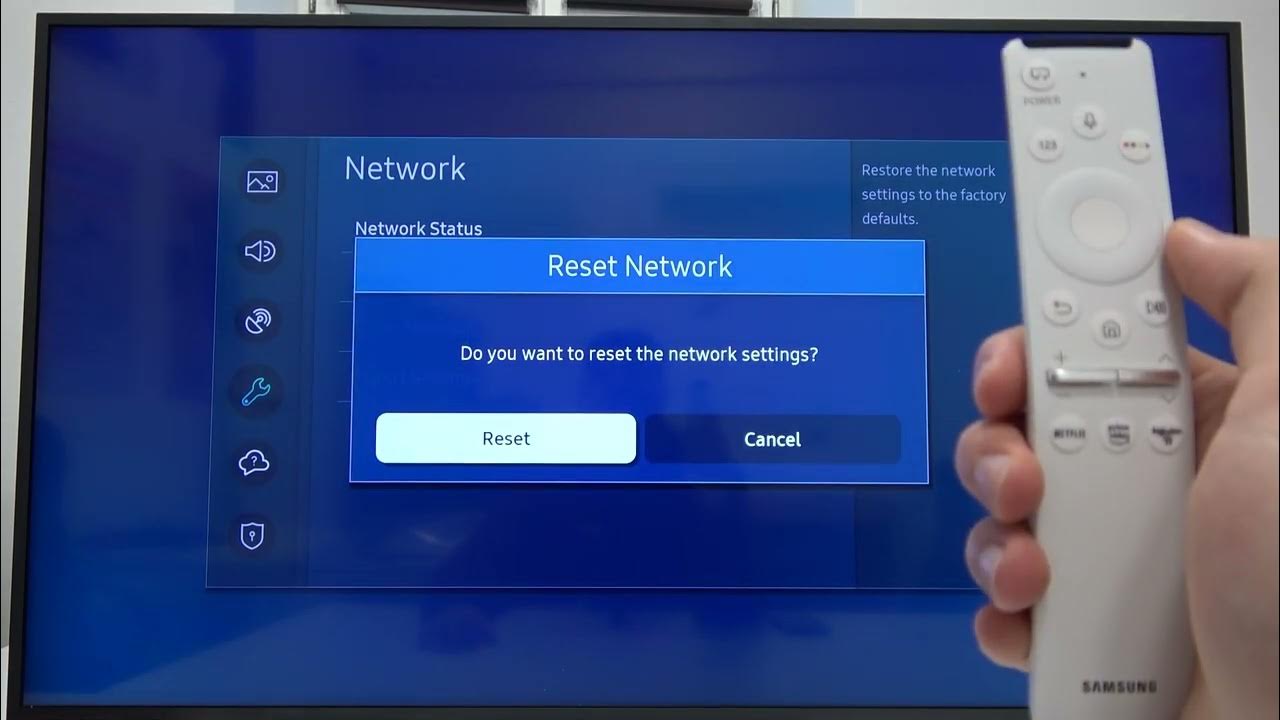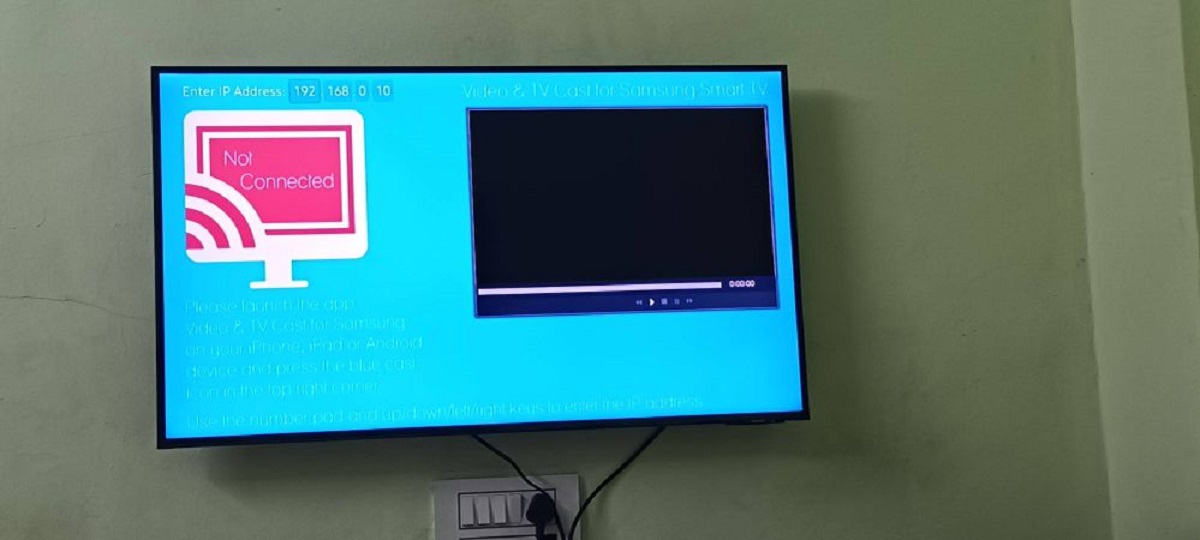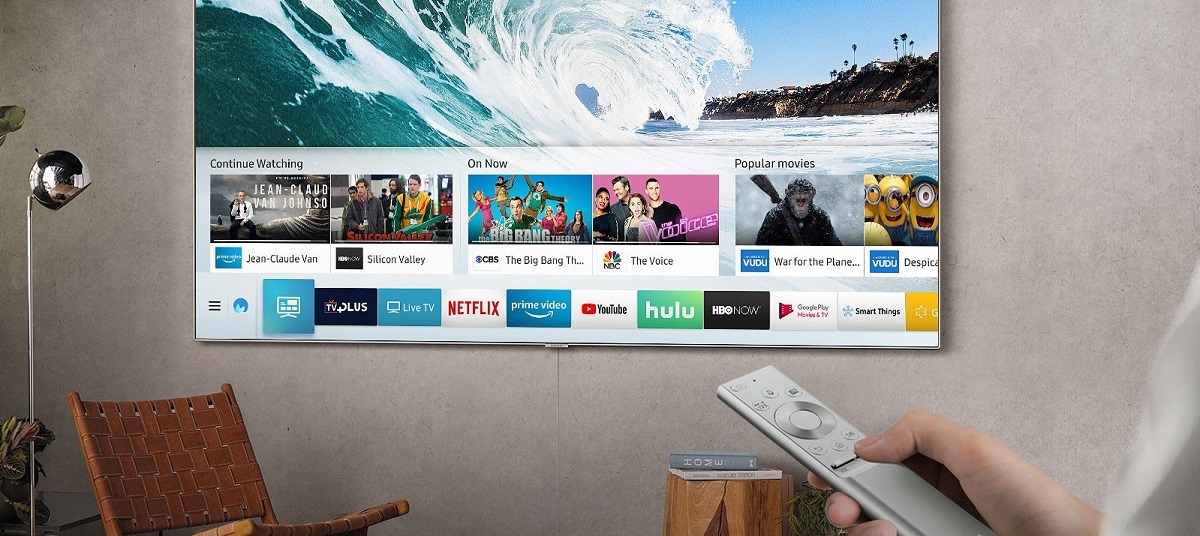Possible Reasons for Wi-Fi Connection Issues
Having trouble connecting your Samsung Smart TV to Wi-Fi? There could be several reasons why you’re facing this issue. Understanding these possible reasons can help you troubleshoot the problem effectively. Here are some common culprits:
1. Insufficient Wi-Fi Signal Strength
A weak Wi-Fi signal can hinder the connection between your TV and the router. Thick walls, long distances, or other physical barriers can weaken the signal strength. Make sure the TV is within range of the Wi-Fi router to ensure a stable connection.
2. Incorrect Wi-Fi Network Settings
Double-check that you have entered the correct Wi-Fi network name (SSID) and password. Incorrectly entered credentials can prevent your TV from connecting to the network.
3. Outdated TV Firmware
An outdated firmware on your Smart TV can sometimes cause Wi-Fi connection problems. Keeping your TV’s firmware up to date ensures compatibility with the latest Wi-Fi protocols and bug fixes.
4. Wi-Fi Router Compatibility Issues
It’s important to ensure that your Wi-Fi router supports the wireless standards compatible with your Samsung Smart TV. Older routers may not support the latest Wi-Fi protocols needed for a stable connection.
5. Interference from Nearby Electronic Devices
Electromagnetic interference from other devices like cordless phones, baby monitors, or microwave ovens can disrupt the Wi-Fi signal. Keep your Wi-Fi router away from such devices to mitigate interference.
6. Router Configuration Problems
Misconfigured router settings can also lead to Wi-Fi connection issues. Check if any firewall settings or MAC address filters are preventing your TV from connecting to the network.
7. Network Security Settings
Ensure that your router’s security settings, such as encryption type and password authentication, are compatible with your Smart TV. Mismatched settings can cause connection problems.
8. Insufficient Memory or Storage Space on the TV
If your TV’s internal memory or storage is full, it may impact the Wi-Fi connectivity. Ensure that there is enough free space for the TV to operate smoothly.
By identifying these possible reasons, you can now move on to the next section to explore troubleshooting steps for fixing the Wi-Fi connection issues on your Samsung Smart TV.
Insufficient Wi-Fi Signal Strength
If your Samsung Smart TV is experiencing Wi-Fi connection issues, one possible reason could be insufficient signal strength. A weak Wi-Fi signal can hamper the connection between your TV and the router, resulting in intermittent or no connection at all. Here are some steps you can take to address this problem:
1. Check the Wi-Fi Signal Strength: On your Smart TV, navigate to the network settings and look for the signal strength indicator. If the signal is weak, consider moving the TV closer to the Wi-Fi router. Obstacles such as walls and furniture can weaken the signal, so finding an optimal location for your TV can significantly improve the signal strength.
2. Use a Wi-Fi Range Extender: If moving the TV closer to the router is not feasible, you can consider using a Wi-Fi range extender. These devices amplify the Wi-Fi signal and extend its coverage area, allowing your TV to connect even if it is far from the router.
3. Reduce Interference: Other electronic devices, such as cordless phones, microwave ovens, or Bluetooth devices, can interfere with the Wi-Fi signal. Keep your TV away from these devices or turn them off temporarily to see if the signal improves.
4. Upgrade Your Wi-Fi Router: If you are using an older Wi-Fi router, it might not provide the necessary signal strength for a smooth connection with your Smart TV. Consider upgrading to a more powerful router that supports the latest Wi-Fi standards and has better range capabilities.
5. Adjust Router Antennas: If your Wi-Fi router has external antennas, try adjusting their positions to optimize signal reception. Positioning the antennas vertically and at different angles can help enhance signal strength.
6. Use a Wired Connection: If all else fails or you require a stable and strong connection, consider using an Ethernet cable to connect your TV directly to the router. This eliminates any Wi-Fi signal issues and ensures a reliable internet connection for streaming and other online activities.
By taking these steps to improve the Wi-Fi signal strength, you can enhance the connectivity between your Samsung Smart TV and the router, ensuring a seamless streaming experience without any interruptions.
Incorrect Wi-Fi Network Settings
Another possible reason why your Samsung Smart TV is not connecting to Wi-Fi could be incorrect network settings. It’s essential to ensure that you have entered the correct Wi-Fi network name (SSID) and password. Here are some steps to troubleshoot and fix this issue:
1. Double-Check Wi-Fi Network Name (SSID): Access the network settings on your TV and verify that the Wi-Fi network name (SSID) matches your router’s network name exactly. Even a small difference, such as a lowercase or uppercase letter, can prevent your TV from connecting to the network.
2. Verify Wi-Fi Password: Confirm that you have entered the correct Wi-Fi password. Passwords are case-sensitive, so ensure that you enter uppercase and lowercase letters, numbers, and symbols accurately.
3. Reset Wi-Fi Network Settings: If you’re still facing issues, you can reset the Wi-Fi network settings on your TV. Go to the network settings section and look for the option to reset or forget the Wi-Fi network. Once done, reconnect to the network and re-enter the correct login credentials.
4. Restart Router: Sometimes, restarting the router can help resolve network connection issues. Power off the router, wait for a few seconds, and then power it back on. Once the router is back online, try reconnecting your TV to the Wi-Fi network.
5. Update Router Firmware: Check if there are any firmware updates available for your router. Outdated router firmware can cause compatibility issues and hinder Wi-Fi connections. Refer to your router’s manual or the manufacturer’s website for instructions on how to update the firmware.
6. Contact Your Internet Service Provider (ISP): If you’ve confirmed that the network settings on your TV are correct, and you’re still unable to connect to Wi-Fi, reach out to your ISP for support. They can assist in troubleshooting any network-related issues and ensure that the Wi-Fi signal strength is sufficient.
By taking these steps, you can rectify any incorrect Wi-Fi network settings and establish a solid connection between your Samsung Smart TV and your Wi-Fi network.
Outdated TV Firmware
An outdated firmware on your Samsung Smart TV can also be a potential cause for Wi-Fi connection issues. Firmware updates not only provide new features but also address bugs and improve compatibility with Wi-Fi protocols. To resolve this issue, follow these steps:
1. Check for Firmware Updates: Access the settings menu on your Smart TV and navigate to the “Software Update” or “Firmware Update” section. Select “Check for Updates” to see if any new firmware versions are available.
2. Update TV Firmware: If an update is available, proceed with the firmware update installation. Ensure your TV remains connected to the Wi-Fi network during this process. Depending on your TV model and the size of the update, it may take some time to complete.
3. Automatic Updates: Enable the automatic firmware update option on your TV if available. This ensures that your Smart TV stays up to date with the latest firmware releases, providing better compatibility with Wi-Fi networks and addressing any known issues.
4. Firmware Update via USB: In case your TV doesn’t support automatic updates or if you encounter any issues with the internet connection, you can manually update the firmware using a USB drive. Visit the official Samsung support website, download the latest firmware version compatible with your TV model, and follow the instructions provided to install the update.
5. Contact Samsung Support: If you’re unable to update the firmware on your own or continue facing Wi-Fi connection issues even after updating, reach out to Samsung’s customer support. They can provide further assistance and guide you through the process of resolving firmware-related issues.
Updating your TV’s firmware ensures that it is running on the latest software version, which includes important Wi-Fi compatibility improvements. By keeping your Samsung Smart TV firmware up to date, you can enhance the Wi-Fi connectivity and enjoy uninterrupted access to online content and streaming services.
Wi-Fi Router Compatibility Issues
Wi-Fi router compatibility can be another underlying factor causing connectivity problems for your Samsung Smart TV. It’s crucial to ensure that your router supports the wireless standards compatible with your TV model. Here’s what you can do to address compatibility issues:
1. Check Wi-Fi Standards: Verify the Wi-Fi standards supported by your Smart TV. Most modern TVs support the 802.11n or 802.11ac standards. Check if your router supports the same standards. Older routers may only support older Wi-Fi standards, such as 802.11g or 802.11b, which might not provide optimal connectivity.
2. Upgrade Your Router: If your router is not compatible with the required Wi-Fi standards, consider upgrading to a new router that supports the ones required by your TV. Look for routers with dual-band capabilities and advanced features to ensure a stable connection.
3. Router Placement: The physical placement of your router can also impact the Wi-Fi signal strength and compatibility. Position your router in a central location in your home, away from obstructions such as walls, electronics, or other large objects. This ensures that the Wi-Fi signal reaches your TV without interference.
4. Router Antennas: If your router has external antennas, adjustable them to improve signal strength and coverage. Experiment with different angles and orientations to find the best configuration for optimum signal reception.
5. Adjust Channel Settings: Check if your router is set to automatically select the Wi-Fi channel. If not, manually select a channel with less congestion to avoid interference from neighboring Wi-Fi networks. This can help improve compatibility and reduce signal interference.
6. Wi-Fi Extender or Mesh Network: If your router is in a different part of the house and the signal strength is weak near your TV, consider using a Wi-Fi extender or setting up a mesh network. These devices can extend the range of your Wi-Fi network and improve compatibility by ensuring a strong and consistent signal throughout your home.
If you continue to experience compatibility issues with your Wi-Fi router and Smart TV, it is recommended to contact your router manufacturer’s support or seek assistance from a networking professional. They can provide further guidance on router settings, compatibility, or suggest additional solutions to establish a seamless connection between your Samsung Smart TV and the Wi-Fi network.
Interference from Nearby Electronic Devices
Interference from nearby electronic devices can disrupt the Wi-Fi signal and lead to connectivity issues on your Samsung Smart TV. Here are some possible sources of interference and steps to mitigate their impact:
1. Cordless Phones and Baby Monitors: Cordless phones and baby monitors operate on similar frequencies as Wi-Fi networks. Keep your TV and Wi-Fi router away from these devices or choose Wi-Fi channels that are further away from their frequency bands to minimize interference.
2. Microwave Ovens: Microwave ovens emit electromagnetic radiation, which can interfere with Wi-Fi signals. Keep your Smart TV away from the microwave or position your router farthest from the kitchen area to reduce the impact of interference.
3. Bluetooth Devices: Bluetooth devices, such as wireless keyboards or speakers, can interfere with Wi-Fi signals, especially if they are in close proximity to your TV or router. Keep them at a distance or disable Bluetooth temporarily to see if it improves the connection stability.
4. Wireless Security Cameras: Wireless security cameras operating on the same 2.4 GHz frequency as Wi-Fi networks can cause interference. If you have security cameras in your home, make sure they are positioned away from your TV and router or switch to cameras that operate on different frequency bands.
5. Other Wi-Fi Networks: In densely populated areas, multiple Wi-Fi networks can operate on the same or adjacent channels, leading to interference. Use Wi-Fi analyzer tools to identify the least congested channel and manually set your router to operate on it for better compatibility.
6. Physical Obstructions: Walls, furniture, and other obstacles can obstruct the Wi-Fi signal, leading to weaker connectivity. Ensure that your TV and router have a clear line of sight or minimize the number of obstacles between them to improve signal quality.
7. Powerline Adapters or Ethernet over Power: If you are using powerline adapters or Ethernet over power to extend your network, be aware that they can introduce electrical noise and interfere with Wi-Fi signals. Consider repositioning or disconnecting them to test if they are the source of the interference.
By identifying and addressing potential sources of interference, you can significantly improve the Wi-Fi connectivity on your Samsung Smart TV. Experiment with different positions, distances, and channels to minimize interference and ensure a stable and uninterrupted streaming experience.
Router Configuration Problems
In some cases, router configuration problems can be the reason behind Wi-Fi connection issues on your Samsung Smart TV. Incorrect router settings can prevent your TV from establishing a successful connection. Here are some common router configuration problems and steps to resolve them:
1. Firewall Settings: Check if your router’s firewall is blocking the connection between your TV and the Wi-Fi network. Temporarily disable the firewall or add an exception for your TV’s IP address to allow it to connect to the network.
2. MAC Address Filtering: MAC address filtering is a security feature that only allows specific devices to connect to the Wi-Fi network. Ensure that your TV’s MAC address is added to the allowed list in the router’s settings.
3. Quality of Service (QoS) Settings: QoS settings prioritize network traffic for specific devices or applications. If your router has QoS enabled, confirm that the TV’s MAC address or IP address is assigned a higher priority to ensure smooth streaming and a stable connection.
4. DNS Settings: Incorrect DNS settings can cause a variety of network issues. Ensure that your router is configured to use the correct DNS servers provided by your internet service provider (ISP) or switch to a reliable public DNS server, such as Google DNS or Cloudflare DNS.
5. MTU Size: The Maximum Transmission Unit (MTU) size is the largest packet size that can be transmitted over your network. An incorrect MTU size can cause packet loss and connectivity problems. Set the MTU size on your router to the recommended value (usually 1500) for optimal compatibility.
6. Router Firmware: Outdated router firmware can cause compatibility issues and impact Wi-Fi performance. Check if there are any firmware updates available for your router model and install them following the manufacturer’s instructions to ensure optimal functionality.
7. Factory Reset: If you’re still encountering issues after checking and adjusting router settings, try performing a factory reset on your router. This will restore all settings to their default values, allowing you to start the configuration from scratch.
If you’re unsure about making changes to your router’s configuration, consult the user manual or contact the router manufacturer’s support for guidance. They can provide specific instructions based on your router model and help you troubleshoot and resolve any configuration-related problems.
Network Security Settings
Network security settings can also play a role in causing connectivity issues for your Samsung Smart TV. Incorrect or incompatible security settings can prevent your TV from connecting to the Wi-Fi network. Here are some steps to ensure your network security settings are properly configured:
1. Security Encryption: Check if your router is using the correct security encryption method. Common encryption options include WEP, WPA, and WPA2. It is recommended to use WPA2 (or WPA3 if supported) as it provides stronger security compared to older encryption methods like WEP.
2. Security Password: Ensure that you have set a strong password for your Wi-Fi network. A strong password contains a combination of upper and lowercase letters, numbers, and special characters. Avoid using easily guessable passwords or common phrases.
3. Password Authentication Type: Verify that the authentication type on your router matches the one supported by your Smart TV. Common authentication types include WPA-PSK (Pre-Shared Key) and WPA2-PSK. Consult your TV’s manual or the manufacturer’s website for the supported authentication types.
4. Hidden SSID: If you have enabled the option to hide your Wi-Fi network’s SSID (network name), ensure that you enter the SSID correctly on your TV. Alternatively, consider broadcasting the SSID temporarily while you connect your TV to the network and then hide it again for improved security.
5. MAC Address Filtering: MAC address filtering allows you to restrict Wi-Fi access to specific devices based on their unique MAC addresses. Ensure that your TV’s MAC address is added to the allowed list in the router’s settings to grant it access to the network.
6. Guest Network Access: Some routers offer a guest network feature that allows you to create a separate network for visitors. Check if your TV is connecting to the main network rather than the guest network to avoid authentication or access issues.
7. Router Security Updates: Regularly check for firmware updates for your Wi-Fi router. Router manufacturers often release security patches and updates to address vulnerabilities. Keeping your router’s firmware up to date ensures a secure and compatible connection for your Smart TV.
By reviewing and adjusting your network security settings, you can ensure that your Samsung Smart TV successfully connects to your Wi-Fi network while maintaining a safe and secure online environment.
Insufficient Memory or Storage Space on the TV
If your Samsung Smart TV is experiencing Wi-Fi connection issues, it is possible that the TV’s memory or storage space is insufficient. Limited memory or storage can impact the TV’s ability to handle network-related tasks and establish a stable connection. Here’s how you can address this problem:
1. Clear Cache and Temporary Files: Navigate to the settings menu on your TV and look for the option to clear cache or temporary files. This will free up some memory and potentially resolve any memory-related issues affecting the Wi-Fi connection.
2. Remove Unnecessary Apps: If your Smart TV allows you to install apps, consider removing any unused or unnecessary apps. Having too many apps installed can consume memory and impact the overall performance of the TV, including Wi-Fi connectivity.
3. Delete Unnecessary Files: If your TV has internal storage, check if there are any unnecessary files taking up space. Delete any downloaded videos, images, or other files that are no longer needed to free up storage and potentially improve Wi-Fi performance.
4. External Storage Option: Some Samsung Smart TVs have the option to connect external storage devices, such as USB drives or external hard drives. If your TV supports this feature, consider using an external storage device to offload some files and create additional space on the TV’s internal storage.
5. Factory Reset: Performing a factory reset will restore your TV to its original settings, including freeing up memory and storage space. However, note that this will erase all personal settings and data, so make sure to back up any important files before resetting the TV.
6. Contact Samsung Support: If you have tried the above steps and are still experiencing Wi-Fi connection issues due to insufficient memory or storage, it is recommended to reach out to Samsung support for further assistance. They can provide specific guidance for your TV model and help troubleshoot any underlying issues.
By addressing insufficient memory or storage space on your Samsung Smart TV, you can optimize its performance and potentially resolve any Wi-Fi connection issues related to memory limitations.
Troubleshooting Steps to Fix Wi-Fi Connection Issues
If you’re facing Wi-Fi connection issues on your Samsung Smart TV, there are several troubleshooting steps you can take to fix the problem. Follow these steps to ensure a stable and reliable Wi-Fi connection:
1. Resetting the Network Settings on the TV: Start by resetting the network settings on your Smart TV. Access the network settings menu and look for the option to reset or forget the Wi-Fi network. Once done, reconnect to the network and re-enter the correct login credentials.
2. Power Cycling the TV and Router: Turn off both your Smart TV and Wi-Fi router. Wait for a few minutes and then power them back on. This can help refresh the network connections and resolve any temporary glitches causing the connection issues.
3. Updating TV Firmware to the Latest Version: Check if there are any firmware updates available for your Smart TV. Outdated firmware can cause compatibility issues with Wi-Fi networks. Install the latest firmware version following the instructions provided by Samsung to ensure optimal performance.
4. Checking Wi-Fi Signal Strength: Verify the strength of the Wi-Fi signal near your TV. In the network settings on your TV, look for the signal strength indicator. If the signal is weak, consider moving the TV closer to the router or using Wi-Fi range extenders to boost the signal.
5. Moving the TV Closer to the Router: If possible, place your Smart TV in closer proximity to the Wi-Fi router. Physical obstructions and distance can weaken the Wi-Fi signal. By moving the TV closer, you can improve the signal strength and enhance the connectivity.
6. Changing Wi-Fi Network Settings on the TV: Double-check the Wi-Fi network settings on the TV, including the network name (SSID) and password. Ensure that you have entered them correctly, as even a minor error can prevent your TV from connecting to the network.
7. Contacting Samsung Support for Further Assistance: If none of the above steps resolve the Wi-Fi connection issues, it’s recommended to contact Samsung support for further assistance. They have specialized knowledge and resources to help diagnose and resolve any persistent connectivity problems.
By following these troubleshooting steps, you can effectively address Wi-Fi connection issues on your Samsung Smart TV and enjoy uninterrupted streaming and online content access.
Resetting the Network Settings on the TV
Resetting the network settings on your Samsung Smart TV can be an effective troubleshooting step to fix Wi-Fi connection issues. This process helps clear any network-related configurations or settings that may be causing problems. Here’s how to reset the network settings on your TV:
1. Go to the Network Settings: Start by accessing the settings menu on your Smart TV. Locate the network settings section, which may be labeled as “Network,” “Internet,” or “Wi-Fi.”
2. Find the Reset or Forget Network Option: Within the network settings, search for an option to reset or forget the Wi-Fi network. This option is typically found within the Wi-Fi or wireless network settings. It may be listed as “Reset Network,” “Forget Network,” or something similar.
3. Confirm the Reset: Once you have located the reset option, select it to initiate the reset process. You may be prompted to confirm your action. Proceed with the confirmation to reset the network settings.
4. Reconnect to the Wi-Fi Network: After resetting the network settings, your Smart TV will no longer be connected to any Wi-Fi network. Go back to the network settings menu and find the option to connect to a Wi-Fi network. Select your desired network from the available list and enter the correct network name (SSID) and password.
5. Test the Connection: Once you have reconnected to the Wi-Fi network, perform a test to check if the connection issue has been resolved. Access online apps, streaming services, or perform any other network-dependent function to ensure the Wi-Fi connection is stable and reliable.
6. Adjust Additional Network Settings: If you are still experiencing Wi-Fi connection issues after resetting the network settings, consider adjusting other network-related settings on the TV. This includes options such as IP settings, DNS settings, or proxy settings. Ensure these settings are correctly configured for your network setup.
7. Contact Samsung Support: If resetting the network settings does not resolve the Wi-Fi connection issues, it is recommended to reach out to Samsung support for further assistance. They have the expertise to diagnose and troubleshoot more complex network-related problems.
By following these steps and resetting the network settings on your Samsung Smart TV, you can often resolve Wi-Fi connection issues and restore a reliable internet connection for streaming, browsing, and other online activities.
Power Cycling the TV and Router
Power cycling your Samsung Smart TV and Wi-Fi router is a simple yet effective troubleshooting step to resolve Wi-Fi connection issues. This process helps refresh the network connections and can clear any temporary glitches that may be affecting the connection. Here’s how to power cycle your TV and router:
1. Turn off the TV: Start by turning off your Samsung Smart TV. Locate the power button on the TV itself or use the remote control to power it off. Ensure that the TV is completely powered off and not just in standby mode.
2. Unplug the TV from the Power Outlet: After turning off the TV, unplug the power cord from the electrical outlet. This will fully disconnect the TV from the power source and cut off any residual power.
3. Turn off the Router: Locate the power button on your Wi-Fi router and turn it off. If there is no power button, simply unplug the power adapter from the electrical outlet to shut down the router.
4. Wait for a Few Minutes: Once both the TV and router are powered off, wait for at least two to three minutes. This timeframe allows any residual charge to dissipate and helps clear any temporary issues within the devices.
5. Plug in the Router and Turn it On: After the waiting period, plug the power adapter back into the electrical outlet and turn on your Wi-Fi router. Wait for the router to fully power up, usually indicated by stable indicator lights or a connection confirmation on the router’s control panel.
6. Power on the TV: Once the router is fully powered on, plug the TV’s power cord back into the electrical outlet and turn on your Samsung Smart TV. Use the TV’s power button or the remote control to power it on. Wait for the TV to fully boot up.
7. Reconnect to the Wi-Fi Network: After both devices have been powered on, go to the network settings on your TV and connect to your Wi-Fi network. Enter the correct network name (SSID) and password to establish a new connection.
8. Test the Connection: Perform a test to check if the Wi-Fi connection issue has been resolved. Open an app, stream a video, or perform any network-dependent task to ensure a stable and reliable connection.
If power cycling the TV and router does not resolve the Wi-Fi connection issues, you may need to proceed with additional troubleshooting steps or contact Samsung support for further assistance.
Updating TV Firmware to the Latest Version
Updating the firmware of your Samsung Smart TV to the latest version is an essential step to troubleshoot and fix Wi-Fi connection issues. Firmware updates not only introduce new features and improvements but also address bugs and compatibility issues with Wi-Fi networks. Here’s how you can update the firmware on your TV:
1. Check for Updates: Access the settings menu on your Smart TV. Look for the “Software Update” or “Firmware Update” section. Select the option to check for updates. The TV will connect to the internet and search for the latest firmware version available for your model.
2. Download the Firmware: If an update is found, follow the prompts to download the firmware. Make sure you have a stable internet connection during the download process. The size of the update may vary, so it might take a few minutes or longer to complete the download.
3. Install the Firmware: Once the firmware is downloaded, the TV will prompt you to install it. Confirm the installation and follow the on-screen instructions. The TV will automatically restart during the installation process. Do not turn off the TV or disconnect it from the power source while the firmware is being installed.
4. Ensure a Stable Connection: It is crucial to ensure a stable and uninterrupted Wi-Fi connection during the firmware update process. A loss of connection or interruption can lead to an incomplete or failed update. Ensure that the Wi-Fi signal strength is strong and there are no temporary connectivity issues.
5. Alternative Update Methods: If your Smart TV does not have an internet connection or if you encounter difficulties with the online update process, you can manually update the firmware using a USB drive. Visit the official Samsung support website, locate the firmware update file specific to your TV model, download it to a USB drive, and follow the instructions provided to complete the update via USB.
6. Periodic Check for Updates: Firmware updates are released periodically to address new issues or enhance performance. Make it a habit to periodically check for firmware updates on your Smart TV, especially if you are experiencing persistent Wi-Fi connection issues. Updating to the latest firmware version helps maintain optimal compatibility with Wi-Fi networks.
By diligently updating the firmware on your Samsung Smart TV, you can ensure that your TV remains compatible with the latest Wi-Fi standards and improve the stability and reliability of your Wi-Fi connection.
Checking Wi-Fi Signal Strength
One of the key factors that can affect Wi-Fi connection performance on your Samsung Smart TV is the signal strength. If the Wi-Fi signal is weak or too far from the TV, it can result in poor connectivity and unstable network performance. Here are some steps to check and improve the Wi-Fi signal strength:
1. Assess the Signal Indicator: Access the network settings on your Smart TV and locate the Wi-Fi signal strength indicator. This can be displayed as bars or a signal meter. Evaluate the strength of the signal based on the indicator to determine if it is weak or strong.
2. Check the Distance: Verify the distance between your Smart TV and the Wi-Fi router. If the TV is located far away from the router, the Wi-Fi signal may struggle to reach it. Ideally, the TV should be within a reasonable distance from the router to ensure a reliable and stable connection.
3. Remove Obstacles: Identify any physical obstacles that may obstruct the Wi-Fi signal, such as thick walls, furniture, or other electronic devices. Re-position your Smart TV or adjust the router’s location to minimize these obstacles and allow for better signal propagation.
4. Wi-Fi Range Extenders: Consider using Wi-Fi range extenders or repeaters if the Wi-Fi signal strength is consistently weak in the area where your Smart TV is located. These devices can boost the Wi-Fi signal and extend its reach, ensuring better signal strength for your TV.
5. Channel Congestion: Check if there are multiple Wi-Fi networks operating on the same or nearby channels in your area. This can lead to signal interference. Use a Wi-Fi analyzer tool or app to identify the least congested channel, and manually set your router to operate on that channel for improved signal quality.
6. Wi-Fi Antenna Positioning: If your Wi-Fi router has adjustable antennas, experiment with different positions and orientations. Positioning them vertically or using a combination of vertical and horizontal orientations can help optimize signal reception and improve the Wi-Fi signal strength.
7. Consider Wi-Fi Mesh Systems: Wi-Fi mesh systems consist of multiple devices placed strategically throughout your home to provide seamless Wi-Fi coverage. This can help eliminate Wi-Fi dead zones, ensuring better overall signal strength and stability for all your connected devices, including your Samsung Smart TV.
8. Test Signal Strength in Different Locations: If possible, move your Smart TV to different locations within the same room or different rooms to see if the Wi-Fi signal strength improves. Observe the signal indicator on the TV and choose a location where the signal strength is the strongest.
By assessing and optimizing the Wi-Fi signal strength for your Samsung Smart TV, you can achieve a more stable and reliable connection, enabling uninterrupted streaming, online gaming, and other internet-dependent activities.
Moving the TV Closer to the Router
If you’re experiencing Wi-Fi connection issues on your Samsung Smart TV, one solution to consider is moving the TV closer to the router. By reducing the distance between the TV and the router, you can improve the Wi-Fi signal strength and establish a more stable connection. Here are some steps to help you move the TV closer to the router:
1. Assess the Current Setup: Evaluate the current placement of your Smart TV and the Wi-Fi router. Note the distance between them and any physical obstacles that may hinder the Wi-Fi signal, such as walls or furniture.
2. Find an Optimal Location: Identify a location in your home where you can move the TV closer to the router. Ideally, this location should be within a reasonable distance from the router and have minimal obstructions that could weaken the Wi-Fi signal.
3. Consider Cable Length and Connections: Ensure that you have sufficient length in the power cord and any necessary cables (such as HDMI or audio cables) to connect your TV to other devices or the wall outlet in the new location.
4. Plan the Route: Determine the best path to move the TV to the new location. Take into account any potential hazards, such as tripping hazards or fragile objects that could be bumped or damaged during the moving process.
5. Power Off the TV: Before moving the TV, make sure to power it off and unplug it from the electrical outlet. This will prevent any potential damage to the TV and ensure your safety as you relocate it.
6. Unplug and Move the TV: Carefully unplug any cables connected to the TV, such as the power cord, HDMI cables, or audio cables. Gently lift and move the TV to the new location, taking care not to drop or tilt it excessively.
7. Reconnect the TV: Once the TV is in the new location, reconnect the cables, ensuring they are securely connected. Plug the power cord back into the electrical outlet, and reconnect any additional devices or peripherals as necessary.
8. Access Network Settings: Access the network settings on your Smart TV and reconnect to the Wi-Fi network in the new location. Enter the correct network name (SSID) and password, and allow the TV to establish a new connection.
9. Test the Connection: Perform a test to check if the Wi-Fi connection is now stable and reliable. Open an app, stream a video, or perform any network-dependent tasks to ensure the new placement has improved the Wi-Fi signal strength.
By moving your Samsung Smart TV closer to the Wi-Fi router, you can enhance the Wi-Fi signal strength and improve the overall connectivity, ensuring a more seamless streaming experience and uninterrupted access to online content.
Changing Wi-Fi Network Settings on the TV
If you’re experiencing Wi-Fi connection issues on your Samsung Smart TV, it may be necessary to change the Wi-Fi network settings on the TV itself. This can involve modifying the Wi-Fi network name (SSID) or password to ensure the correct and updated settings are in place. Here’s how you can change the Wi-Fi network settings on your TV:
1. Access the Network Settings: Go to the settings menu on your Smart TV. Look for the network or Wi-Fi settings section, which may be labeled differently depending on your TV model.
2. Select the Wi-Fi Network: Within the network settings, select the option to view available Wi-Fi networks. Choose your current Wi-Fi network from the list of available networks.
3. Adjust the Network Settings: Depending on your TV model, you may have options to modify the network settings. Look for options such as “Edit network,” “Change network settings,” or a similar label.
4. Update the Network Name (SSID): If you are changing the Wi-Fi network name (SSID), enter the new name in the designated field. Ensure that the new name exactly matches the SSID of your Wi-Fi network. Be cautious to accurately input uppercase and lowercase letters, as SSIDs are case-sensitive.
5. Modify the Wi-Fi Password: If you need to update the Wi-Fi password, enter the new password in the appropriate field. Ensure that the new password matches the current password for your Wi-Fi network. Pay attention to capitalization and special characters, as typed passwords must be accurate.
6. Save the Changes: Once you have made the necessary modifications to the Wi-Fi network settings, select the option to save or apply the changes. The TV will attempt to connect to the newly specified Wi-Fi network using the updated settings.
7. Test the Connection: After saving the changes, perform a test to check if the Wi-Fi connection is stable and functioning properly. Access apps, stream content, or perform any network-dependent tasks to ensure a successful connection.
8. Troubleshoot if Needed: If changing the Wi-Fi network settings on the TV does not resolve the connection issues, consider other troubleshooting steps such as power cycling the TV and router, or contacting Samsung support for further assistance.
By adjusting the Wi-Fi network settings on your Samsung Smart TV, you can ensure the correct information is entered, establishing a reliable and stable connection to your Wi-Fi network for an uninterrupted streaming and online experience.
Contacting Samsung Support for Further Assistance
If you’ve followed the troubleshooting steps and are still experiencing Wi-Fi connection issues with your Samsung Smart TV, it is recommended to reach out to Samsung support for further assistance. Their technical experts can provide specialized guidance to help diagnose and resolve the problem. Here’s how you can contact Samsung support:
1. Visit the Samsung Support Website: Go to the official Samsung support website using your web browser. Look for the “Support” or “Contact” section, which may vary depending on your region.
2. Choose Your TV Model: Locate your specific TV model from the provided options or enter the model number to access the support resources tailored to your device.
3. Explore Support Options: Samsung offers various support options, such as live chat, phone support, email support, and community forums. Choose the option that best suits your needs and preferences.
4. Live Chat: If live chat support is available, it can be a convenient way to get immediate assistance. Connect with a Samsung representative who can guide you through troubleshooting steps or escalate the issue if necessary.
5. Phone Support: Samsung provides phone support, and you can find the relevant contact number on the support page. Call the designated phone number to speak directly with a support representative who can provide personalized assistance.
6. Email Support: If you prefer to communicate via email, check if email support is available. Fill out the contact form with your inquiry and provide detailed information about the Wi-Fi connection issues you are experiencing.
7. Community Forums: Samsung’s community forums are a valuable resource where you can engage with other users and Samsung experts. Search for existing threads related to Wi-Fi connection issues on your specific Smart TV model or start a new thread to seek assistance.
8. Provide Relevant Information: When contacting Samsung support, be prepared to provide relevant information such as your TV model number, firmware version, and a detailed description of the Wi-Fi connection issues you are facing. This will help the support team better understand the problem and provide more accurate assistance.
Remember to remain patient and cooperative during your interaction with Samsung support. They are dedicated to resolving any issues you encounter with your Smart TV and will work with you to find the best possible solution.







